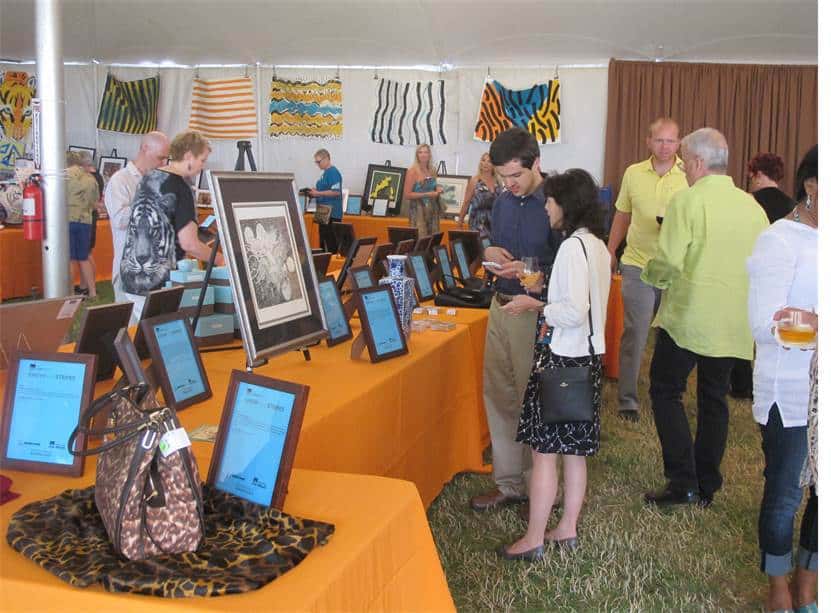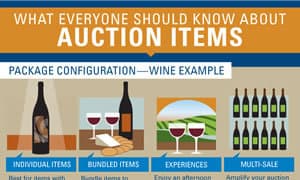
Ask someone for advice on the number of packages needed to make a silent auction truly shine and you might receive a response like, “as many as you can get.”
When planning a benefit, we generally don’t spend time worrying about procuring too much; if anything, we worry about not having enough.
But dig a little deeper and you’d find that most seasoned fundraising professionals agree there is a sweet spot between too many silent auction packages and too few. More is not always better and in fact, too many choices can be detrimental to the participant experience and the bottom line. Some fundraisers even argue that silent auctions work best when the offerings on display are minimized to the point of scant.
In truth, there is no one-size-fits-all guide to finding this sweet spot; it varies with the uniqueness of each event. The size of the organization, number of attendees, experience of the fundraising team, revenue goals, and event history all influence how an auction takes shape.
In this two-part series, we take a look at the central factors surrounding the question, How many biddable items should my silent auction have? In part one, we introduce the concept of choice overload and take a bird’s eye look at pros and cons on both sides of the size spectrum. In part two, we present a set of practical approaches that can be adopted to find your own silent auction sweet spot.
The problem with choice
Alongside the rise of consumerism, psychologists and economists have sought to understand the role of choice in decision-making. Researchers have found that our brains can struggle to cope under the weight of too many choices, leading to inaction. This is a cognitive process sometimes referred to as choice overload (most of us will have experienced this personally).
Choice overload is a useful concept, but does this mean that adopting a universal “less is more” approach to building a silent auction makes sense? In short, no. Fundraising events are far too complex and multi-faceted to hold up under blanket statements. But we can use this concept as a starting point to think about how we can manage the size and set-up of our silent auctions to minimize choice overload and maximize the bidding experience.
On the small side
The thought of a silent auction with few bidding packages on display makes fundraisers nervous for good reason. To start, sizing down an auction could mean turning donations away, and sparse bidding tables can be visually unappealing and reflect poorly on the organization in general. People attend silent auctions because they care about the cause and our job is to provide plenty of opportunities for them to give. Those attendees that “come to shop” want variety and are at risk of becoming antsy or bored. At worse, some may leave early and decide not to participate in subsequent years. We want people to bid, feel they have “won” something, leave happy, and return next year with friends in tow!

Despite all this, auctions that are on the small side inherently possess a couple of important benefits. Most obviously, the risk of choice overload is greatly diminished. And fewer items at play promotes competition between bidders and may lead to higher per-item earnings (supply economics is just as much at play in the non-profit, event planning world). A scarcity of goods changes the way that buyers value the purchase.
On the large side
A silent auction that brims over with donations may, on its face, seem destined for financial success. However, we now know that choice overload can act as a deterrent for bidders and an oversupply will most likely to lead to lower per-item earnings. Furthermore, bidding tables can quickly become cluttered and disorganized, and heavily crowded walkways will keep some potential bidders away entirely. Additional staff and volunteers are needed as auction sizes increase, and the check-out process must be efficient and fluid or chaos (and long lines) will quickly ensue.
The clock is ticking and time is always an important consideration for event planners. Large auctions inherently require more time spent walking the room (or scrolling the mobile bidding app). This can make it difficult to stay on schedule and may jeopardize participant’s overall experience. Guests who spend the entire evening browsing will be less available to soak in the social mission of the organization. Large silent auctions also risk competing with other fundraising aspects of the event, such as raffles and live auctions. As a rule of thumb, live auctions typically generate 60-70% of the event’s revenue, so inducing bidding fatigue prior could be detrimental to revenue goals.
On the flip side, the largest of silent auctions can be sensational experiences and tremendous money-makers. Greater number of items and packages inevitably leads to more variety and improves the likelihood that there will be something for everyone. Bidders will be happy to find options at various price points (nobody wants to browse a bunch of items that they can’t afford).
So, where does this leave us?
There is no right or wrong answer to the question of auction size; nevertheless, there are some universal principles that we can all get behind. More is not always better: too much can leave you with items that sell well below their value. Choice overload and supply economics are at play in silent auctions and should be taken into consideration.
The most profitable (and enjoyable) auctions are planned carefully and intentionally, making use of a set of industry best practices. In the second part of this article series, we narrate these strategies and lay the groundwork for a silent auction that hits the sweet spot (trust us, this is information you don’t want to skip).
